- Joined
- Oct 9, 2007
- Messages
- 47,233 (7.55/day)
- Location
- Hyderabad, India
| System Name | RBMK-1000 |
|---|---|
| Processor | AMD Ryzen 7 5700G |
| Motherboard | ASUS ROG Strix B450-E Gaming |
| Cooling | DeepCool Gammax L240 V2 |
| Memory | 2x 8GB G.Skill Sniper X |
| Video Card(s) | Palit GeForce RTX 2080 SUPER GameRock |
| Storage | Western Digital Black NVMe 512GB |
| Display(s) | BenQ 1440p 60 Hz 27-inch |
| Case | Corsair Carbide 100R |
| Audio Device(s) | ASUS SupremeFX S1220A |
| Power Supply | Cooler Master MWE Gold 650W |
| Mouse | ASUS ROG Strix Impact |
| Keyboard | Gamdias Hermes E2 |
| Software | Windows 11 Pro |
AMD today unveiled its next-generation Ryzen 7000 desktop processors, based on the Socket AM5 desktop platform. The new Ryzen 7000 series processors introduce the new "Zen 4" microarchitecture, with the company claiming a 15% single-threaded uplift over "Zen 3" (16-core/32-thread Zen 4 processor prototype compared to a Ryzen 9 5950X). Other key specs about the architecture put out by AMD include a doubling in per-core L2 cache to 1 MB, up from 512 KB on all older versions of "Zen." The Ryzen 7000 desktop CPUs will boost to frequencies above 5.5 GHz. Based on the way AMD has worded their claims, it seems that the "+15%" number includes IPC gains, plus gains from higher clocks, plus what the DDR4 to DDR5 transition achieves. With Zen 4, AMD is introducing a new instruction set for AI compute acceleration. The transition to the LGA1718 Socket AM5 allows AMD to use next-generation I/O, including DDR5 memory, and PCI-Express Gen 5, both for the graphics card, and the M.2 NVMe slot attached to the CPU socket.
Much like Ryzen 3000 "Matisse," and Ryzen 5000 "Vermeer," the Ryzen 7000 "Raphael" desktop processor is a multi-chip module with up to two "Zen 4" CCDs (CPU core dies), and one I/O controller die. The CCDs are built on the 5 nm silicon fabrication process, while the I/O die is built on the 6 nm process, a significant upgrade from previous-generation I/O dies that were built on 12 nm. The leap to 5 nm for the CCD enables AMD to cram up to 16 "Zen 4" cores per socket, all of which are "performance" cores. The "Zen 4" CPU core is larger, on account of more number-crunching machinery to achieve the IPC increase and new instruction-sets, as well as the larger per-core L2 cache. The cIOD packs a pleasant surprise—an iGPU based on the RDNA2 graphics architecture! Now most Ryzen 7000 processors will pack integrated graphics, just like Intel Core desktop processors.
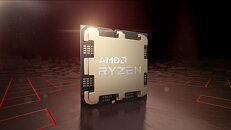
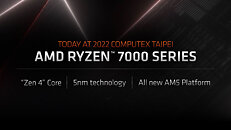
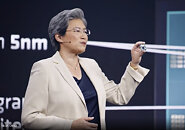
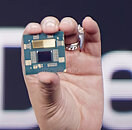
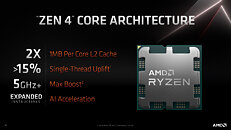
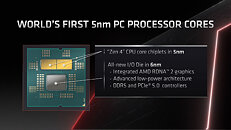
The Socket AM5 platform is capable of up to 24 PCI-Express 5.0 lanes from the processor. 16 of these are meant for the PCI-Express graphics slots (PEG), while four of these go toward an M.2 NVMe slot attached to the CPU—if you recall, Intel "Alder Lake" processors have 16 Gen 5 lanes toward PEG, but the CPU-attached NVMe slot runs at Gen 4. The processor features dual-channel DDR5 (four sub-channel) memory, identical to "Alder Lake," but with no DDR4 memory support. Unlike Intel, the AM5 Socket retains cooler compatibility with AM4, so the cooler you have sitting on your Ryzen CPU right now, will work perfectly fine.
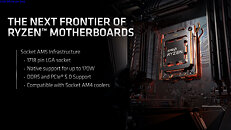
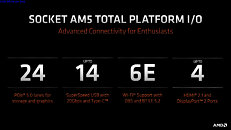
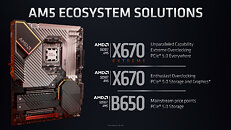
The platform also puts out up to 14 USB 20 Gbps ports, including type-C. With onboard graphics now making it to most processor models, motherboards will feature up to four DisplayPort 2 or HDMI 2.1 ports. The company will also standardize Wi-Fi 6E + Bluetooth WLAN solutions it co-developed with MediaTek, weaning motherboard designers away from Intel-made WLAN solutions.
At its launch, in Fall 2022, AMD's AM5 platform will come with three motherboard chipset options—the AMD X670 Extreme (X670E), the AMD X670, and the AMD B650. The X670 Extreme was probably made by re-purposing the new-generation 6 nm cIOD die to work as a motherboard chipset, which means its 24 PCIe Gen 5 lanes work toward building an "all Gen 5" motherboard platform. The X670 (non-extreme), is very likely a rebadged X570, which means you get up to 20 Gen 4 PCIe lanes from the chipset, while retaining PCIe Gen 5 PEG and CPU-attached NVMe connectivity. The B650 chipset is designed to offer Gen 4 PCIe PEG, Gen 5 CPU-attached NVMe, and likely Gen 3 connectivity from the chipset.
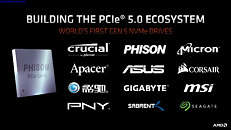
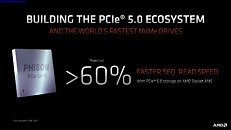
AMD is betting big on next-generation M.2 NVMe SSDs with PCI-Express Gen 5, and is gunning to be the first desktop platform with PCIe Gen 5-based M.2 slots. The company is said to be working with Phison to optimize the first round of Gen 5 SSDs for the platform.
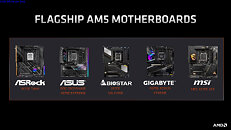
All major motherboard vendors are ready with Socket AM5 motherboards. AMD showcased a handful, including the ASUS ROG Crosshair X670E Extreme, the ASRock X670E Taichi, MSI MEG X670E ACE, GIGABYTE X670E AORUS Xtreme, and the BIOSTAR X670E Valkyrie.
AMD is working to introduce several platform-level innovations like it did with Smart Access Memory with its Radeon RX 6000 series, which builds on top of the PCIe Resizable BAR technology by the PCI-SIG. The new AMD Smart Access Storage technology builds on Microsoft DirectStorage, by adding AMD platform-awareness, and optimization for AMD CPU and GPU architectures. DirectStorage enables direct transfers between a storage device and the GPU memory, without the data having to route through the CPU cores. In terms of power delivery Zen 4 uses the same SVI3 voltage control interface that we saw introduced on the Ryzen Mobile 6000 Series. For desktop this means the ability to address a higher number of VRM phases and to process voltage changes much faster than with SVI2 on AM4.

Taking a closer look at the AMD Footnotes, "RPL-001", we find out that the "15% IPC gain" figure is measured using Cinebench and compares a Ryzen 9 5950X processor (not 5800X3D), on a Socket AM4 platform with DDR4-3600 CL16 memory, to the new Zen 4 platform running at DDR5-6000 CL30 memory. If we go by the measurements from our Alder Lake DDR5 Performance Scaling article, then this memory difference alone will account for roughly 5% of the 15% gains.
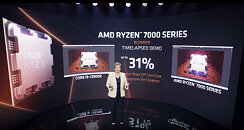

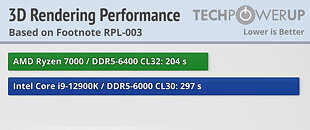
The footnotes also reference a "RPL-003" claim that's not used anywhere in our pre-briefing slide deck, but shown in the video presentation. In the presentation we're seeing a live demo comparison between a "Ryzen 7000 Series" processor and Intel's Core i9-12900K "Alder Lake." It's worth mentioning here that AMD isn't disclosing the exact processor model, only that it's a 16-core part, if we follow the Zen 3 naming, that would probably be the Ryzen 9 7950X flagship. The comparison runs the Blender rendering software, which loads all CPU cores. Here we see the Ryzen 7000 chip finish the task in 204 seconds, compared to the i9-12900K and its 297 seconds time, which is a huge 31% difference—very impressive. It's worth mentioning that the memory configurations are slightly mismatched. Intel is running with DDR5-6000 CL30, whereas the Ryzen is tested with DDR5-6400 CL32—lower latency for Intel, higher MHz for Ryzen. While ideally we'd like to see identical memory used, the differences due to the memory configuration should be very small.
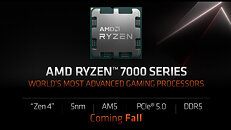
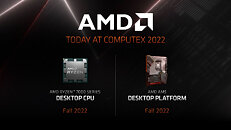
AMD is targeting a Fall 2022 launch for the Ryzen 7000 "Zen 4" desktop processor family, which would put this sometime between September thru October. The company is likely to detail the "Zen 4" microarchitecture and the Ryzen 7000 SKU list in the coming weeks.
Update 21:00 UTC: AMD has clarified that the 170 W PPT power numbers seen are the absolute max limits, not "typical" like the 105 W, on Zen 3, which were often exceeded during heavy usage.
Update May 26th: AMD further clarified that the 170 W number is "TDP", not "PPT", which means that when the usual x1.35 factor is applied, actual power usage can go up to 230 W.
You can watch the whole presentation again at YouTube:
View at TechPowerUp Main Site
Much like Ryzen 3000 "Matisse," and Ryzen 5000 "Vermeer," the Ryzen 7000 "Raphael" desktop processor is a multi-chip module with up to two "Zen 4" CCDs (CPU core dies), and one I/O controller die. The CCDs are built on the 5 nm silicon fabrication process, while the I/O die is built on the 6 nm process, a significant upgrade from previous-generation I/O dies that were built on 12 nm. The leap to 5 nm for the CCD enables AMD to cram up to 16 "Zen 4" cores per socket, all of which are "performance" cores. The "Zen 4" CPU core is larger, on account of more number-crunching machinery to achieve the IPC increase and new instruction-sets, as well as the larger per-core L2 cache. The cIOD packs a pleasant surprise—an iGPU based on the RDNA2 graphics architecture! Now most Ryzen 7000 processors will pack integrated graphics, just like Intel Core desktop processors.






The Socket AM5 platform is capable of up to 24 PCI-Express 5.0 lanes from the processor. 16 of these are meant for the PCI-Express graphics slots (PEG), while four of these go toward an M.2 NVMe slot attached to the CPU—if you recall, Intel "Alder Lake" processors have 16 Gen 5 lanes toward PEG, but the CPU-attached NVMe slot runs at Gen 4. The processor features dual-channel DDR5 (four sub-channel) memory, identical to "Alder Lake," but with no DDR4 memory support. Unlike Intel, the AM5 Socket retains cooler compatibility with AM4, so the cooler you have sitting on your Ryzen CPU right now, will work perfectly fine.



The platform also puts out up to 14 USB 20 Gbps ports, including type-C. With onboard graphics now making it to most processor models, motherboards will feature up to four DisplayPort 2 or HDMI 2.1 ports. The company will also standardize Wi-Fi 6E + Bluetooth WLAN solutions it co-developed with MediaTek, weaning motherboard designers away from Intel-made WLAN solutions.
At its launch, in Fall 2022, AMD's AM5 platform will come with three motherboard chipset options—the AMD X670 Extreme (X670E), the AMD X670, and the AMD B650. The X670 Extreme was probably made by re-purposing the new-generation 6 nm cIOD die to work as a motherboard chipset, which means its 24 PCIe Gen 5 lanes work toward building an "all Gen 5" motherboard platform. The X670 (non-extreme), is very likely a rebadged X570, which means you get up to 20 Gen 4 PCIe lanes from the chipset, while retaining PCIe Gen 5 PEG and CPU-attached NVMe connectivity. The B650 chipset is designed to offer Gen 4 PCIe PEG, Gen 5 CPU-attached NVMe, and likely Gen 3 connectivity from the chipset.


AMD is betting big on next-generation M.2 NVMe SSDs with PCI-Express Gen 5, and is gunning to be the first desktop platform with PCIe Gen 5-based M.2 slots. The company is said to be working with Phison to optimize the first round of Gen 5 SSDs for the platform.

All major motherboard vendors are ready with Socket AM5 motherboards. AMD showcased a handful, including the ASUS ROG Crosshair X670E Extreme, the ASRock X670E Taichi, MSI MEG X670E ACE, GIGABYTE X670E AORUS Xtreme, and the BIOSTAR X670E Valkyrie.
AMD is working to introduce several platform-level innovations like it did with Smart Access Memory with its Radeon RX 6000 series, which builds on top of the PCIe Resizable BAR technology by the PCI-SIG. The new AMD Smart Access Storage technology builds on Microsoft DirectStorage, by adding AMD platform-awareness, and optimization for AMD CPU and GPU architectures. DirectStorage enables direct transfers between a storage device and the GPU memory, without the data having to route through the CPU cores. In terms of power delivery Zen 4 uses the same SVI3 voltage control interface that we saw introduced on the Ryzen Mobile 6000 Series. For desktop this means the ability to address a higher number of VRM phases and to process voltage changes much faster than with SVI2 on AM4.

Taking a closer look at the AMD Footnotes, "RPL-001", we find out that the "15% IPC gain" figure is measured using Cinebench and compares a Ryzen 9 5950X processor (not 5800X3D), on a Socket AM4 platform with DDR4-3600 CL16 memory, to the new Zen 4 platform running at DDR5-6000 CL30 memory. If we go by the measurements from our Alder Lake DDR5 Performance Scaling article, then this memory difference alone will account for roughly 5% of the 15% gains.



The footnotes also reference a "RPL-003" claim that's not used anywhere in our pre-briefing slide deck, but shown in the video presentation. In the presentation we're seeing a live demo comparison between a "Ryzen 7000 Series" processor and Intel's Core i9-12900K "Alder Lake." It's worth mentioning here that AMD isn't disclosing the exact processor model, only that it's a 16-core part, if we follow the Zen 3 naming, that would probably be the Ryzen 9 7950X flagship. The comparison runs the Blender rendering software, which loads all CPU cores. Here we see the Ryzen 7000 chip finish the task in 204 seconds, compared to the i9-12900K and its 297 seconds time, which is a huge 31% difference—very impressive. It's worth mentioning that the memory configurations are slightly mismatched. Intel is running with DDR5-6000 CL30, whereas the Ryzen is tested with DDR5-6400 CL32—lower latency for Intel, higher MHz for Ryzen. While ideally we'd like to see identical memory used, the differences due to the memory configuration should be very small.


AMD is targeting a Fall 2022 launch for the Ryzen 7000 "Zen 4" desktop processor family, which would put this sometime between September thru October. The company is likely to detail the "Zen 4" microarchitecture and the Ryzen 7000 SKU list in the coming weeks.
Update 21:00 UTC: AMD has clarified that the 170 W PPT power numbers seen are the absolute max limits, not "typical" like the 105 W, on Zen 3, which were often exceeded during heavy usage.
Update May 26th: AMD further clarified that the 170 W number is "TDP", not "PPT", which means that when the usual x1.35 factor is applied, actual power usage can go up to 230 W.
You can watch the whole presentation again at YouTube:
View at TechPowerUp Main Site





